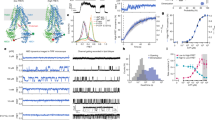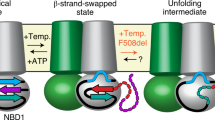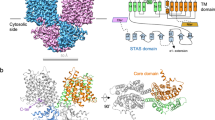Abstract
Critical mutations in the membrane-spanning domains of proteins cause many human diseases. We report the expression in Escherichia coli of helix-loop-helix segments of the cystic fibrosis transmembrane conductance regulator (CFTR) chloride channel domain in milligram quantities. Analysis of gel migration patterns of these constructs, in conjunction with circular dichroism spectroscopy, demonstrate that a neutral-to-charged, CF-phenotypic point mutation of a hydrophobic residue (V232D) in the CFTR transmembrane (TM) helix 4 induces a hydrogen bond with neighboring wild type Gln 207 in TM helix 3. As an electrostatic crosslink within a hydrocarbon phase, such a hydrogen bond could alter the normal assembly and alignment of CFTR TM helices and/or impede their movement in response to substrate transport. Our results imply that membrane proteins may be vulnerable to loss of function through formation of membrane-buried interhelical hydrogen bonds by partnering of proximal polar side chains.
This is a preview of subscription content, access via your institution
Access options
Subscribe to this journal
Receive 12 print issues and online access
$189.00 per year
only $15.75 per issue
Buy this article
- Purchase on Springer Link
- Instant access to full article PDF
Prices may be subject to local taxes which are calculated during checkout



Similar content being viewed by others
References
Creighton, T.E. Proteins: structure and molecular properties (W.H. Freeman and Co., New York; 1992).
White, S.H. & Wimley, W.C. Annu. Rev. Biophys. Biomol. Struct. 28, 319–365 (1999).
Stevens, T.J. & Arkin, I.T. Proteins 36, 135–143 (1999).
Grigorieff, N., Ceska, T.A., Downing, K.H., Baldwin, J.M. & Henderson, R. J. Mol. Biol. 259, 393–421 (1996).
Deisenhofer, J., Epp, O., Sinning, I. & Michel, H. J. Mol. Biol. 246, 429–457 (1995).
Venkatesan, P. & Kaback, H.R. Proc. Natl. Acad. Sci. USA 95, 9802–9807 (1998).
Strader, C.D. et al. J. Biol. Chem. 266, 5–8 (1991).
Perrin, C.L. & Nielson, J.B. Annu. Rev. Phys. Chem. 48, 511–544 (1997).
Choma, C., Gratkowski, H., Lear, J.D. & DeGrado, W.F. Nature Struct. Biol. 7, 161–166 (2000).
Zhou, F.X., Cocco, M.J., Brünger, A.T. & Engelman, D.M. Nature Struct. Biol. 7, 154–160 (2000).
Smith, S.O., Smith, S.C. & Bormann, B.J. Nature Struct. Biol. 3, 252–258 (1996).
Lemmon, M.A. et al. J. Biol. Chem. 267, 7683–7689 (1992).
Deber, C.M. et al. Proc. Natl. Acad. Sci. USA 90, 11648–11652 (1993).
MacKenzie, K.R., Prestgard, J.H. & Engelman, D.M. Science 276, 131–133 (1997).
Sheppard, D.N. & Welsh, M.J. Physiol. Rev. 79, S23–S45 (1999).
Cystic Fibrosis Genetic Analysis Consortium; http://www.genet.sickkids.on.ca/cftr-cgi-bin/MutationTable
Riordan, J.R. et al. Science 245, 1066–1073 (1989).
Bowie, J.U. J. Mol. Biol. 272, 780–789 (1997).
Peng, S., Liu, L.-P., Emili, A.Q. & Deber, C.M. FEBS Lett. 431, 29–33 (1998).
Popot, J.-L. & Engelman, D.M. Annu. Rev. Biochem. 69, 881–922 (2000).
Chu, D.M. et al. J. Biol. Chem. 273, 14649–14656 (1998).
Otsuka, F. et al. Biochim. Biophys. Acta 1492, 330–340 (2000).
Han, J.C. & Han, G.Y. Anal. Biochem. 220, 5–10 (1994).
Fisher, L.E., Engelman, D.M. & Sturgis, J.N. J. Membr. Biol. (1999).
Popot, J. & Engelman, D.M. Biochemistry 29, 4031–4037 (1990).
Ramjeesingh, M., Huan, L.-J., Garami, E. & Bear, C.E. Biochem. J. 342, 119–123 (1999).
Akabas, M.H. Biochemistry 37, 12233–12240 (1998).
Wang, C. & Deber, C.M. J. Biol. Chem. 275, 16155–16159 (2000).
Adams, P.D., Arkin, I.T., Engelman, D.M. & Brünger, A.T. Nature Struct. Biol. 2, 154–162 (1995).
Deber, C. M. et al. Protein Science 10, 212–219 (2001).
Acknowledgements
Supported by grants to C.M.D. from the Canadian Cystic Fibrosis Foundation, the Canadian Institutes of Health Research (CIHR) and the National Institutes of Health (NIDDK). A.G.T. holds a CIHR postdoctoral fellowship. We are grateful to A. Brünger and P. Adams (Yale University) for providing us with the global conformation search program used for the simulation of CFTR helical dimers. We thank C. Wang for assistance with molecular modeling, and M. Glibowicka and W. Chen for technical assistance.
Author information
Authors and Affiliations
Corresponding author
Rights and permissions
About this article
Cite this article
Therien, A., Grant, F. & Deber, C. Interhelical hydrogen bonds in the CFTR membrane domain. Nat Struct Mol Biol 8, 597–601 (2001). https://doi.org/10.1038/89631
Received:
Accepted:
Issue Date:
DOI: https://doi.org/10.1038/89631
This article is cited by
-
A minimal helical-hairpin motif provides molecular-level insights into misfolding and pharmacological rescue of CFTR
Communications Biology (2018)
-
The protein pheromone temptin is an attractant of the gastropod Biomphalaria glabrata
Journal of Comparative Physiology A (2017)
-
Protein folding in membranes
Cellular and Molecular Life Sciences (2010)
-
Changing the Metal Binding Specificity of Superoxide Dismutase from Thermus thermophilus HB-27 by a Single Mutation
Molecular Biotechnology (2009)
-
Application of DETECTER, an evolutionary genomic tool to analyze genetic variation, to the cystic fibrosis gene family
BMC Genomics (2006)



